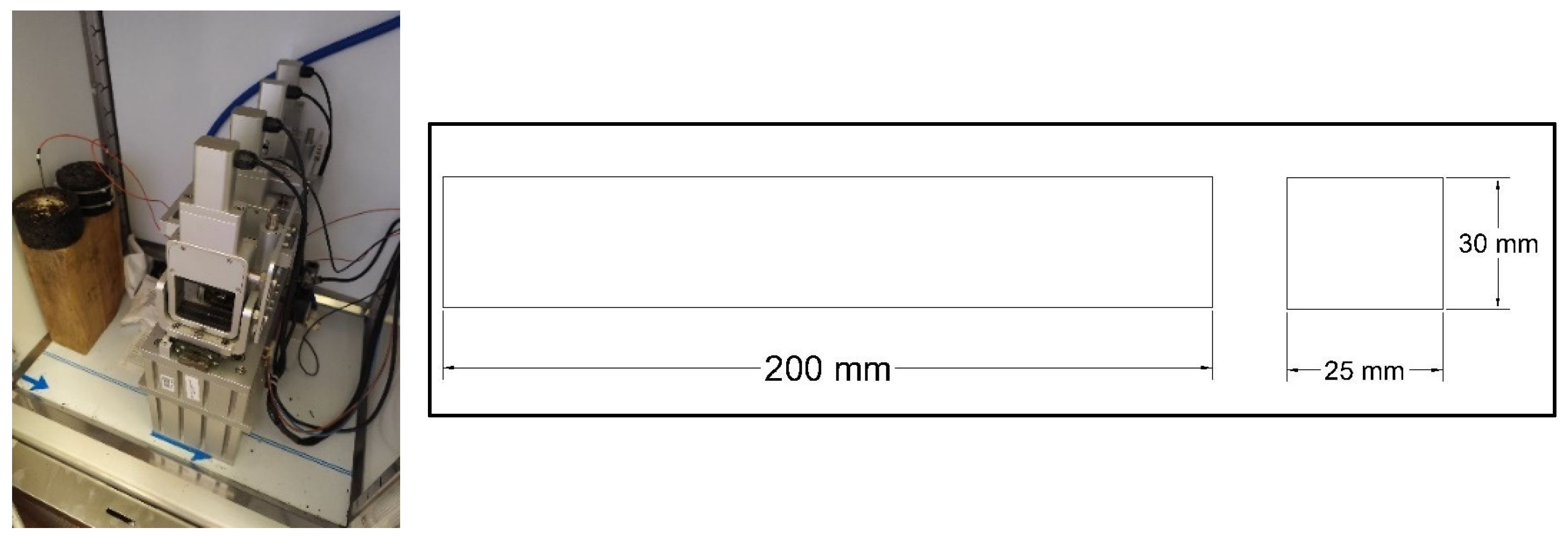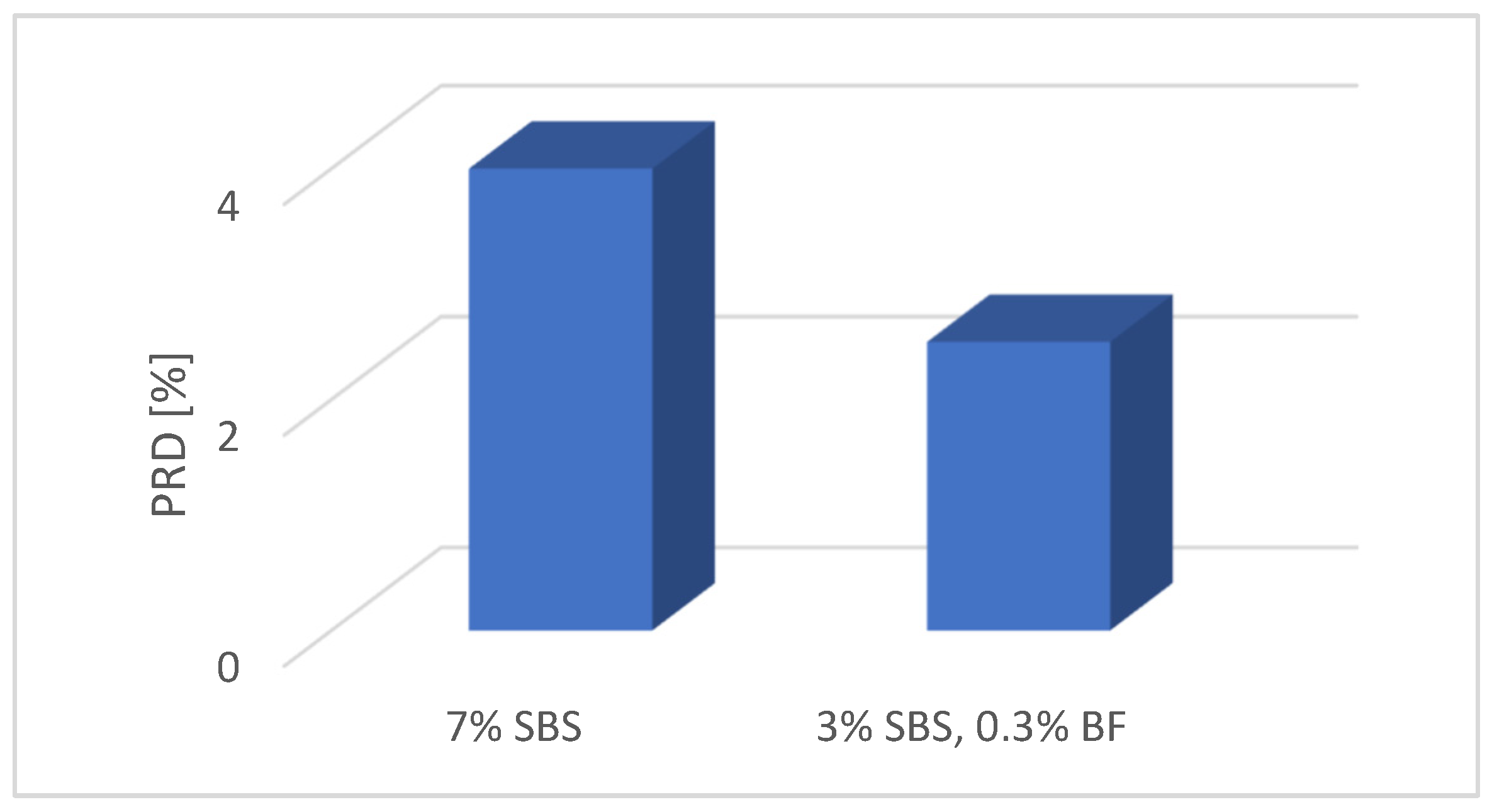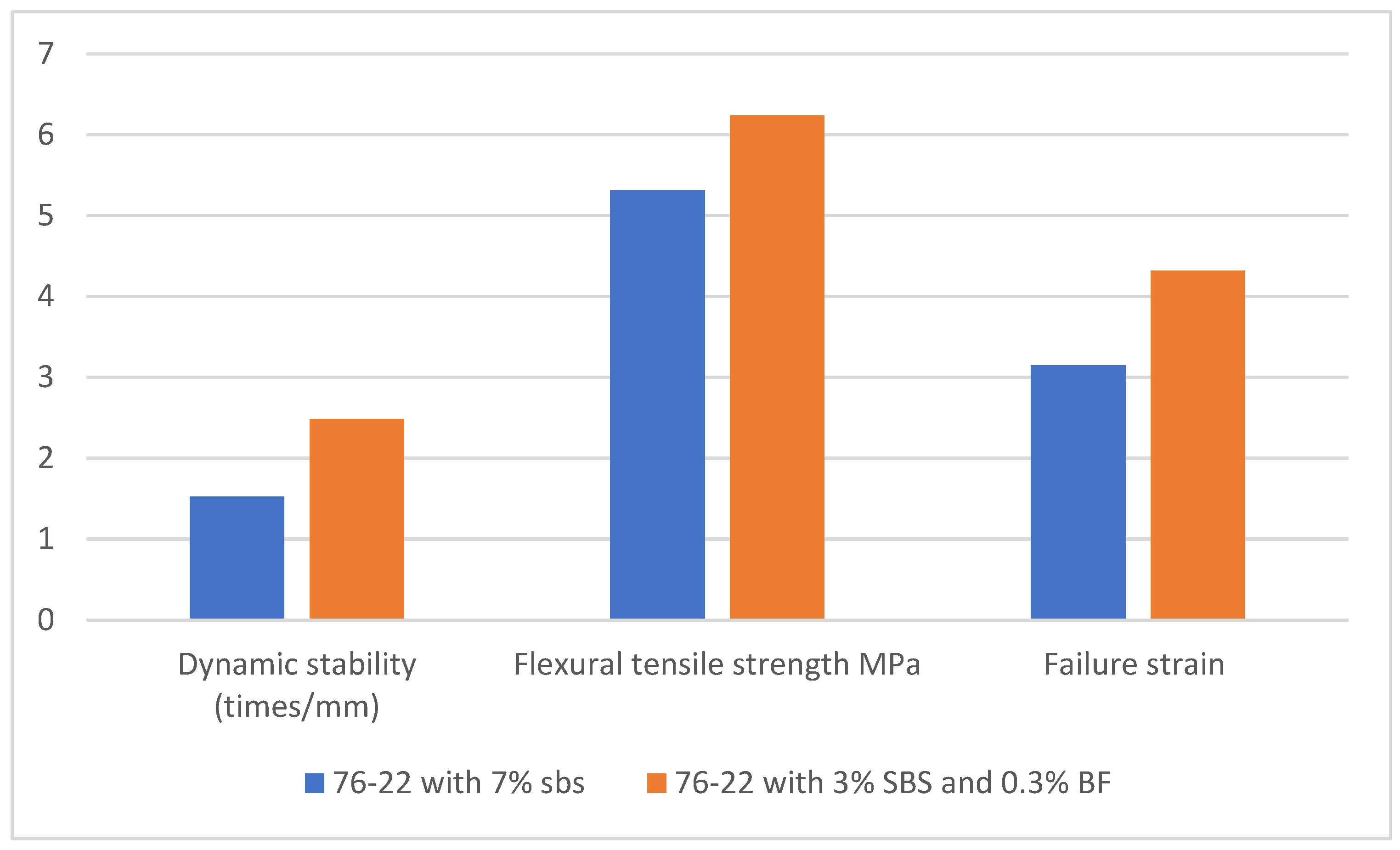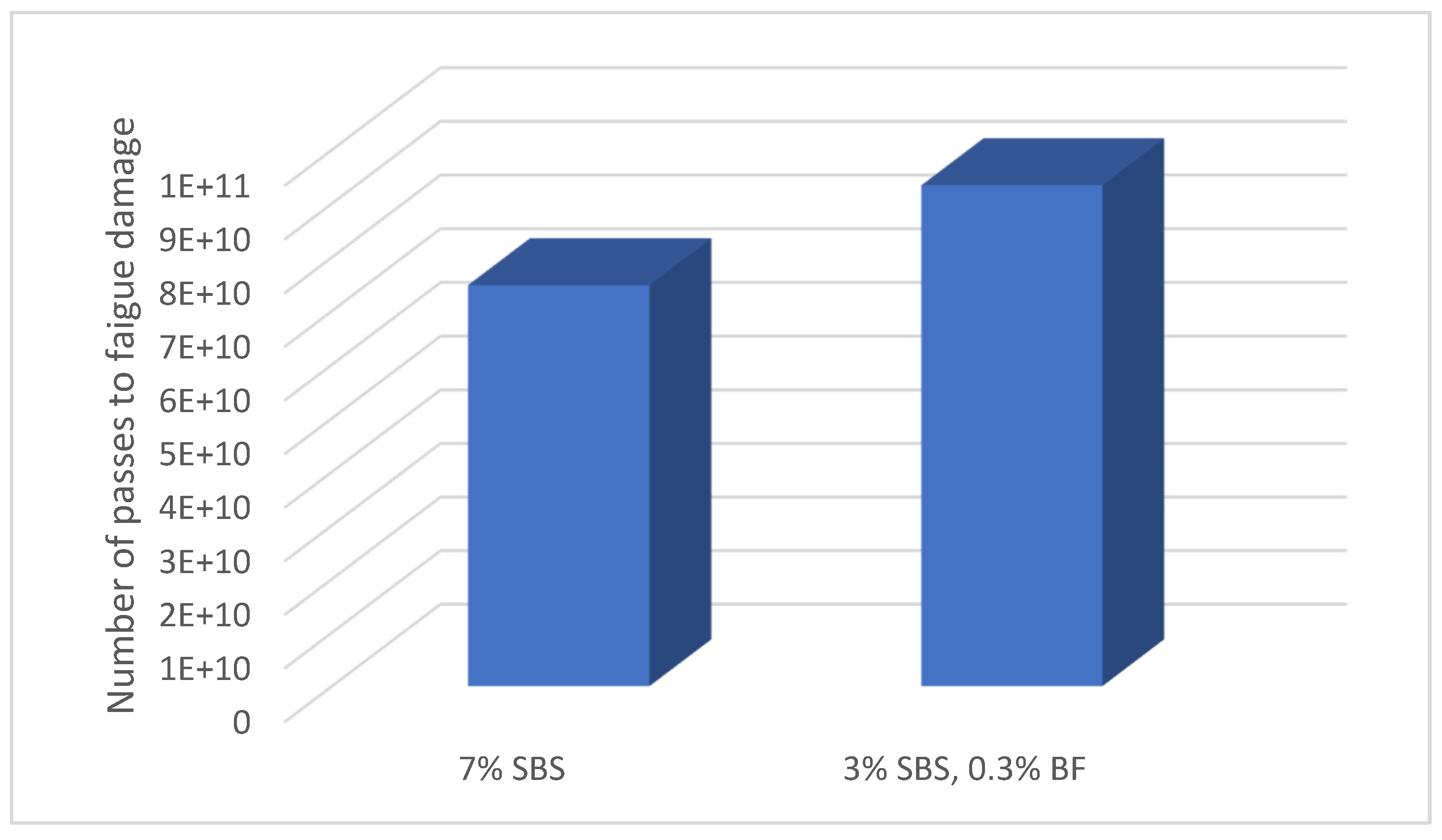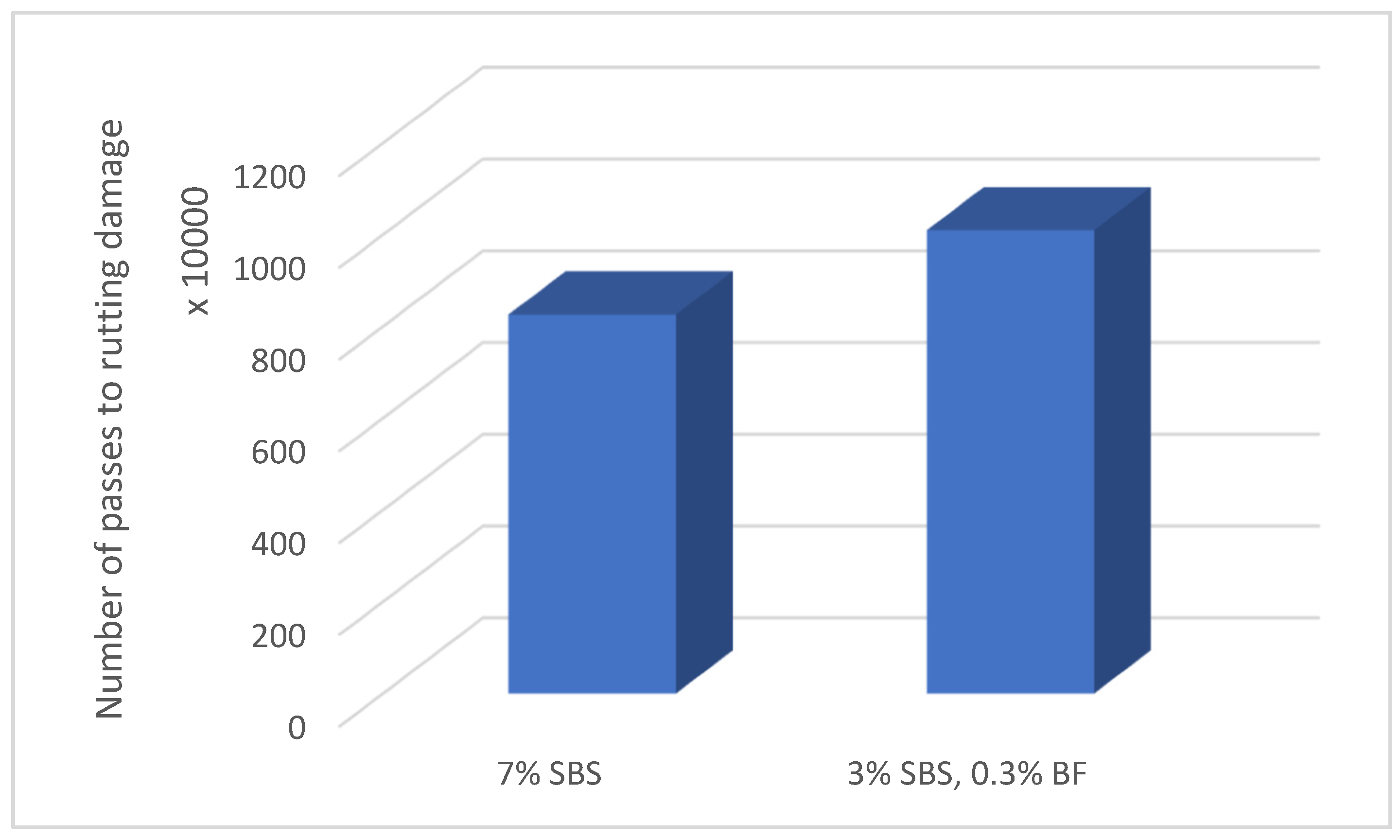1. Introduction
Different modifications in asphalt mixtures can be performed to enhance the high and low temperature performance of asphalt mixtures. Polymer and crumb rubber-modified bitumen mixtures have been used to enhance the viscoelastic properties of asphalt mixtures. Although polymer and crumb rubber-modified mixtures exhibit promising performance in terms of fatigue and rutting resistance, due to rising material costs, some alternative options are available for further optimization of the asphalt mixtures’ performance.
The alternative is to reduce the percentage of polymer or crumb rubber used in the mixtures and, furthermore, the reduction in polymer or crumb rubber can be compensated for by adding fibers to the mixture without compromising the performance of the asphalt mixtures. Furthermore, the performance of completely pure SBS-modified asphalt mixtures and fiber-reinforced-modified asphalt mixtures can be compared in terms of rutting and fatigue damage. Different forms of fibers are commercially available involving basalt fiber, polyester fiber and xylogen fiber [
1]. The usual percentage of these fibers varies from 0.15% to 0.45% depending on the characteristics of the asphalt mixtures.
In terms of the significance of this research, an alternative option is necessary for decreasing the procurement costs of SBS-7% mixtures, since these types of mixtures are mostly used in major highways and airport projects. Therefore, an alternative option is the use of fiber modifications to asphalt mixtures and subsequently decreasing the amount of SBS polymer, thereby improving the economic efficiency of the mixtures. Lab tests and finite element modeling further enhance the rutting depth performance comparisons of SBS-modified mixtures with different percentages and fiber modifications.
The performance of basalt fibers (BFs) is sensitive in terms of the diameter of fibers used in the asphalt mixtures. Commercially available BFs are available with diameters of 7 µm, 16 um and 25 um. The performance of basalt fibers also varies with the proportions of BFs used in the mixtures, with a recommended percentage of 0.3% [
2]. When compared with polyester fiber and xylogen fiber, BF exhibits superior performance in terms of high and low temperature strength enhancement and decreased water sensitivity [
3].
Commercially available fibers can also be obtained in organic and inorganic forms. Lignin fiber has been previously used in the modification of the properties of asphalt mixtures due to its readiness to decompose early [
4]. However, inorganic fibers outperform organic fibers in terms of increased water damage resistance. Furthermore, the use of organic fibers results in increased tensile strength, increased stiffness modulus, increased elasticity, and constancy in physical and chemical properties of asphalt mixtures [
5].
In terms of fibers with inorganic origins, BF is produced from natural basalt. Basalt fiber offers added strength and durability to asphalt mixtures and has good alkali and acidity resistance [
6]. BFs provide better strength than conventional steel-formed fibers and have lower environmental impact when it comes to CO
2 emissions [
7]. Furthermore, in terms of cost efficiency, basalt fibers are less expensive to procure than carbon fibers [
8]. The properties of basalt fibers include being incombustible and resistance against extreme temperature variations.
Basalt fiber has been previously used for performance enhancement of pavements in terms of avoiding raveling in pavements, specifically for porous asphalt pavements and open-graded friction course [
9]. In case of stone matrix asphalt (SMA) mixtures, the introduction of BF can also improve the ductility of asphalt mixtures and enhance the dynamic modulus, compressive strength and temperature sensitivity by providing an adequate operational temperature range [
10].
Due to increasing traffic volume and axle loads, the use of polymer- or crumb rubber-modified mixtures is essential to reduce the amount of maintenance interventions required. Since the use of only polymer and crumb rubber modifiers is costly for the same amount of performance gains for asphalt mixtures, it is essential to introduce cost-effective alternatives by reducing the amount of SBS or CR modifiers needed for asphalt mixtures. Therefore, the percentage of SBS or CR used in asphalt mixtures can be compensated for by adding basalt fiber without compromising the strength of the mixtures. The addition of basalt fiber to the mixtures can further reinforce the polymer matrices in the mixtures, thereby providing adequate strength and stability to the polymer matrices at reduced costs, leading to resistance in raveling, fatigue damage and rutting of the asphalt mixtures [
11].
In terms of rutting performance gains for basalt fiber-modified asphalt mixtures, Celauro et al. [
12] evaluated the rutting progression of asphalt mixtures modified with 0.35 basalt fiber. A wheel tracking test was carried out with loading cycles of 20,000. Results showed that basalt fiber-modified asphalt mixtures exhibited 28% less rutting when compared with conventional HMA mixtures. Zhang et al. [
13] performed the dynamic stability evaluation of asphalt mixtures modified with 0.4% basalt fiber using wheel rutting rests. Results showed a 35% gain in dynamic stability of 0.4% basalt fiber-modified mixtures. Hnag et al. performed a rutting resistance evaluation of 0.4% basalt fiber-modified asphalt mixtures. Results suggested the use of a stone matrix asphalt mixture along with a combination of 0.4% basalt fiber content for increased rutting resistance. Li et al. [
14] evaluated the effect of 16 um and 26 um diameter basalt fiber on low-temperature cracking resistance and high-temperature stability of asphalt mixtures. Wheel tracking tests, semi-circular bending tests and the bending beam test were employed to study the behavior of two different diameter scenarios. Results showed that 16 um diameter basalt fibers outperformed the 26 um diameter type in terms of increased high-temperature stability and increased cracking resistance in low-temperature conditions.
Xing et al. [
15] evaluated the effect of bundled basalt fibers on the performance of asphalt mixtures in terms of rutting resistance using bending beam rheometer and dynamic shear rheology tests. Results showed increased toughness of BF-modified mixtures in high-temperature conditions when compared with lignin fibers. Chen et al. [
16] evaluated the effect of basalt fiber on viscosity and the high-temperature performance of asphalt mixtures. Results showed that adding basalt fiber to the asphalt mixture increased the viscosity and high-temperature performance of asphalt mixtures by creating a strong three-dimensional network. Zheng et al. [
17] performed a dynamic stability and low-temperature performance evaluation of basalt fiber-modified asphalt mixtures at percentages of 0.15%, 0.3% and 0.45%. Results showed improvement in performance of asphalt mixtures by adding an optimum 0.3% basalt fiber in terms of ultimate tensile strength and maximum bending strain of tested specimens. Zhao et al. [
2] carried out a performance evaluation of basalt fiber-modified SBS mixtures and conventional SBS-modified mixtures. Wheel tracking tests and the three-point bending test were used to evaluate the effect of basalt fiber at different percentages. Result showed an optimum percentage of 0.3% basalt fiber, where the dynamic stability and tensile strength ratio increased by 25.5% and 6% when compared with conventional SBS-modified asphalt mixtures. Furthermore, it was found that basalt fiber outperformed both lignin- and polyester fiber-modified asphalt mixtures. Guo et al. [
18] evaluated the high and low temperature properties of asphalt mixtures with fiber proportions of 1%, 2%, 3%, 4% and 5% with fiber lengths of 6 mm, 9 mm and 15 mm. A dynamic shear rheometer and bending beam rheometer were employed to study the rheological properties of various mixture types. Results showed that basalt fiber 2% with 9 mm fiber size outperformed other mixture types, with temperature performance and low-temperature stress dissipating ability. Chauhua et al. [
5] evaluated the effects of basalt fibers on bitumen and asphalt mixtures using various percentages of basalt fiber. Different tests including viscosity, water stability and splitting tensile strength tests were performed on prepared specimens. Results showed an increased stiffness modulus of asphalt mixtures and increased deformation resistance at the recommended basalt fiber percentage of 0.3%.
Shi et al. [
19] evaluated the low-temperature performance of basalt fiber-reinforced asphalt mixtures in terms of freezing and thawing cycles. Basalt fiber rubber composite was used for modifying the asphalt mixtures. Results showed further improvement in performance of the basalt fiber-reinforced asphalt mixtures in terms of freezing and thawing action by 0.3%. Shi et al. [
20] evaluated the high-temperature properties of bundled basalt fiber, lignin fiber and polyester fiber mixed with asphalt mixtures. Results showed increased fracture energy of the asphalt mixtures mixed with basalt fiber and increased high-temperature performance. Hui et al. [
21] evaluated the effect of adding basalt fiber to asphalt mixtures in terms of fatigue cracking, thermal cracking and rutting. Results showed increased cracking and rutting resistance of the asphalt mixtures when reinforced with basalt fiber. Phung et al. [
22] used basalt fiber asphalt concrete for the performance enhancement of asphalt mixtures measured using machine learning models including Gradient Boosting, Particle Swarm Eagle and Bald Eagle Search techniques. Results showed increased performance of the basalt fiber asphalt concrete in terms of Marshall stability, with the highest level of prediction exhibited by the Bald Eagle Search model. Cai et al. [
23] evaluated the impacts of adding basalt fiber on the viscosity, stability and splitting tensile strength of asphalt mixtures. Result showed an increased tensile strength and stiffness modulus of asphalt mixtures with a percentage of 0.3% basalt fiber. Zhu et al. [
24] evaluated the effects of adding basalt fiber, lignin fiber and polyester fiber on the toughness, wear resistance and mechanical strength of asphalt mixtures. Results showed superior performance of asphalt mixtures with basalt fibers in terms of increased rutting and fatigue cracking resistance predicted by using the Random Forest model. Yan et al. [
25] evaluated the effects of adding basalt fiber to SBS-modified asphalt mixtures on aging, freezing and thawing, rutting and low-temperature bending of asphalt mixtures. Results showed increased high-temperature stability and low-temperature cracking resistance of asphalt mixtures with added basalt fiber. Wang et al. [
26] evaluated the effects of adding copped basalt fiber (CBF) on tensile strength, durability, fatigue damage and mechanical strength of asphalt mixtures. Mixtures were prepared with chopped basalt fiber percentages of 3% and 4%. Low-temperature cracking tests, freeze thaw tests and wheel tracking tests were used to evaluate the performance of different percentages and length variations of basalt fiber. Results showed an increased performance of basalt fiber with an optimum fiber length of 6 mm and fiber percentage of 3%. Liu et al. [
27] evaluated the effects of adding basalt fiber to asphalt mixtures in terms of the flexural tensile strength of asphalt mixtures. Results showed increased tensile strength and stiffness modulus of fiber-reinforced asphalt mixtures.
Li et al. [
28] evaluated the effects of basalt fiber on hot-in-place asphalt recycling mixtures. Recycled asphalt mixtures consisted of 70% Recycled Asphalt Pavement (RAP) and 30% new mixture. Dynamic stability and bending beam tests were carried out to evaluate the mixtures’ resistance to rutting and low-temperature cracking. Results showed that the addition of basalt fiber to the recycled asphalt mixtures improved the stripping resistance, rutting resistance and cracking resistance by 46.9%, 105.2% and 102.3%, respectively.
The influence of fibers on asphalt mixtures and their comparison against the different percentages of basalt fibers have not been addressed before with the aid of finite element modeling in previous research; therefore, in this current research, a 3% SBS mixture with basalt fiber was tested against the 7% SBS conventional mixture. Furthermore, the performance evaluation of lignin, basalt and polyester fibers has been compared against the SBS mixture previously; however, in this research, the 3% SBS mixture was used in order to evaluate the performance directly with the SBS-7% mixture in terms of dynamic stability.

